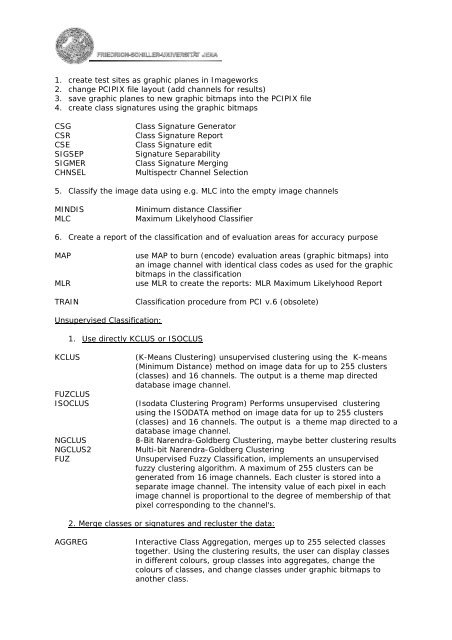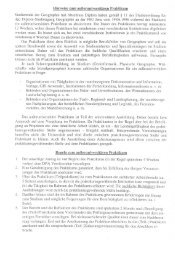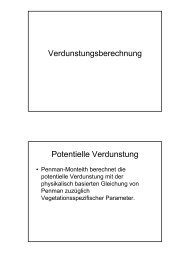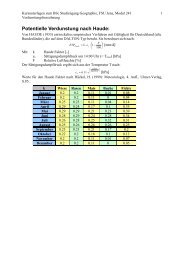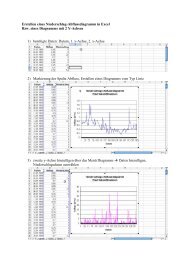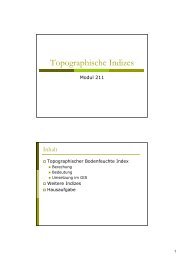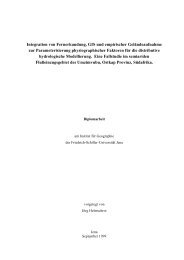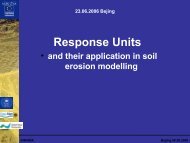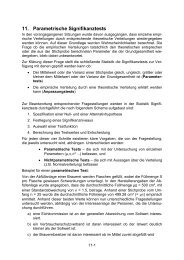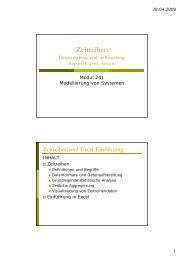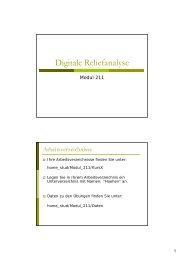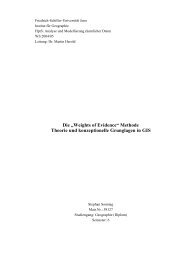Fernerkundung I (Digitale Bildverarbeitung) - Friedrich-Schiller ...
Fernerkundung I (Digitale Bildverarbeitung) - Friedrich-Schiller ...
Fernerkundung I (Digitale Bildverarbeitung) - Friedrich-Schiller ...
You also want an ePaper? Increase the reach of your titles
YUMPU automatically turns print PDFs into web optimized ePapers that Google loves.
1. create test sites as graphic planes in Imageworks<br />
2. change PCIPIX file layout (add channels for results)<br />
3. save graphic planes to new graphic bitmaps into the PCIPIX file<br />
4. create class signatures using the graphic bitmaps<br />
CSG<br />
CSR<br />
CSE<br />
SIGSEP<br />
SIGMER<br />
CHNSEL<br />
Class Signature Generator<br />
Class Signature Report<br />
Class Signature edit<br />
Signature Separability<br />
Class Signature Merging<br />
Multispectr Channel Selection<br />
5. Classify the image data using e.g. MLC into the empty image channels<br />
MINDIS<br />
MLC<br />
Minimum distance Classifier<br />
Maximum Likelyhood Classifier<br />
6. Create a report of the classification and of evaluation areas for accuracy purpose<br />
MAP<br />
MLR<br />
TRAIN<br />
use MAP to burn (encode) evaluation areas (graphic bitmaps) into<br />
an image channel with identical class codes as used for the graphic<br />
bitmaps in the classification<br />
use MLR to create the reports: MLR Maximum Likelyhood Report<br />
Classification procedure from PCI v.6 (obsolete)<br />
Unsupervised Classification:<br />
1. Use directly KCLUS or ISOCLUS<br />
KCLUS<br />
FUZCLUS<br />
ISOCLUS<br />
NGCLUS<br />
NGCLUS2<br />
FUZ<br />
(K-Means Clustering) unsupervised clustering using the K-means<br />
(Minimum Distance) method on image data for up to 255 clusters<br />
(classes) and 16 channels. The output is a theme map directed<br />
database image channel.<br />
(Isodata Clustering Program) Performs unsupervised clustering<br />
using the ISODATA method on image data for up to 255 clusters<br />
(classes) and 16 channels. The output is a theme map directed to a<br />
database image channel.<br />
8-Bit Narendra-Goldberg Clustering, maybe better clustering results<br />
Multi-bit Narendra-Goldberg Clustering<br />
Unsupervised Fuzzy Classification, implements an unsupervised<br />
fuzzy clustering algorithm. A maximum of 255 clusters can be<br />
generated from 16 image channels. Each cluster is stored into a<br />
separate image channel. The intensity value of each pixel in each<br />
image channel is proportional to the degree of membership of that<br />
pixel corresponding to the channel's.<br />
2. Merge classes or signatures and recluster the data:<br />
AGGREG<br />
Interactive Class Aggregation, merges up to 255 selected classes<br />
together. Using the clustering results, the user can display classes<br />
in different colours, group classes into aggregates, change the<br />
colours of classes, and change classes under graphic bitmaps to<br />
another class.


